Three types of new sleigh bells are most often misrepresented as antiques in antique stores, flea markets, and online or live auctions. These are the petal, raspberry, and acorn designs. My goal in this article is to help you identify the modern versions of these sleigh bells from the antique ones.
First, some definitions:
When I use the term "antique" on this website, I am specifically talking about bells made during the "horse and buggy times". Antique North American sleigh bells date from the 1700s through the 1920s.
When I use the terms "new" or "modern" or "vintage" or "reproduction", I am referring to sleigh bells made after the era of horse transportation -- from the 1930s through today.
After reading this article, see also Fakes II: Old Straps that Aren't , Fakes III: Case Studies, Dating Bells, and Bell Designs for more information. You can also compare the antique and new bells we have for sale.
New bells direct from the manufacturer have smooth surfaces with no cracks, holes, dings, or other typical signs of age or use. Artificially aged new bells have a splotchy, rusty color that are never seen on antique bells. Other artificially aged modern bells can be varying shades of green, brown, or even black. Key signs of artificially aged sleigh bells are splotchy color on any one bell and a wide variation in color on bells next to each other on a strap.
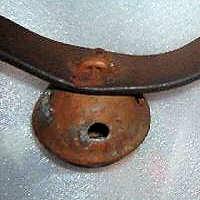
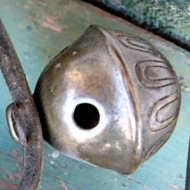
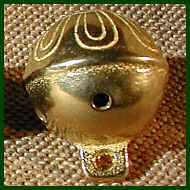
Left: Freshly polished new bell with a bright yellow-gold color.
Middle: New bell with a golden brown patina. This color can be produced quickly by using an antiquing agent or slowly by natural exposure to air.
Right: Bell with a rusty patina not naturally found on brass.
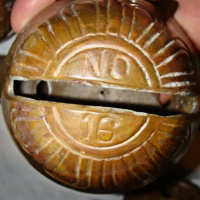
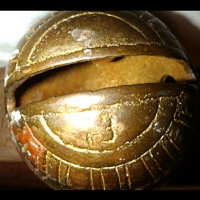

Left: Freshly polished new bell with a bright shine.
Middle: New bell with a slightly-tarnished natural color.
Right: Artificially aged new bell with a typical rusty patina.


Left: Artificially aged new bell with brown patina.
Middle: Artificially aged new bells, one brown and one gray-black, side by side on a strap. This variation in color between adjacent bells would be unusual on an original strap of antique bells.
Right: Artificially aged new bell with a tell-tale splotchy rusty color.


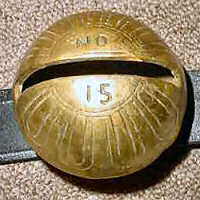
Left: Lightly oxidized new bell.
Middle: New bell with a uniform dull-black artificial finish.
Right: Side view of the same new bell on its weathered black strap.
Unpolished antique bells of any style are brownish, blackish or greenish -- occasionally grayish. The color will be fairly even over the surface of each bell, and all bells on a strap will have consistent coloring. A tough layer of dirt and hardened harness oil often coats old, unpolished bells, making the surface of the bells dull and slightly rough to the touch and obscuring design details. This layer of grime cannot be reproduced by any aging technique that I know of.
Gently polished antique bells of any style tend to have a brownish gold or rosy gold color, sometimes with splotches of darker color. Antique bells often have a textured surface from the sand molds in which they were cast and from the dings and scrapes of long use. This surface texture tends to darken the apparent color of the bell, even after it is polished.
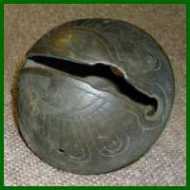

Left: Antique bell gently polished to a soft gold with natural texture
Middle: Antique bell with a light golden-brown natural oxidation and thin surface grime.
Right: Antique bell showing a darker greenish-brown natural oxidation and grime. Note the relatively even color.
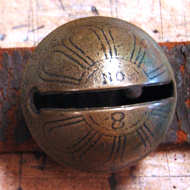
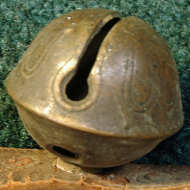
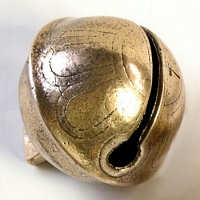
Left: Freshly polished antique bell. Note the surface texture and dark oxidation remaining in the "petal" design.
Middle: Unpolished antique bell with an attractive golden brown color. The variation in color comes from normal handling.
Right: Another golden-brown unpolished antique bell with attractive dark design.
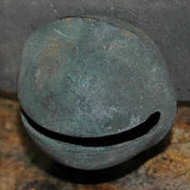

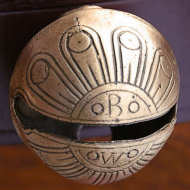
Left: Polished bell dating to the early 1800s with unusual "petal" design and maker's initials.
Middle: Greenish-brown antique bells. Note the variation in design but the similarity in color between these neighboring bells.
Right: Deep greenish-black antique bell. The coating of grime is so thick the design is obscured. Compare the coloring of this bell with the dull-black new bell above.
The classic "petal" bell is the sleigh bell most often sold as an "instant antique". There are several key characteristics that differentiate new petal bells from antique petal bells: the design of the throat (slit), the quality of the ornamentation, and the size of the larger bells.
Throat design: If you take away just one idea from this article, remember this: An antique "petal" bell always has a larger rounded opening cast into each end of its throat (slit.) Modern petal bells have a constant-width throat, with just a few rare exceptions. This rule of thumb works for petal bells, but does not apply to other styles of bells.
Ornamentation: The ornamentation -- the size markings and petal designs -- on new bells will be blocky and plain, often coarse looking, with wide, deep lines. The ornamentation on an antique bell will be more crisp, ornate, and delicate. Study the photographs throughout this article to educate your eye on the differences.


Left: Antique petal bell with a classic rounded opening at each end of its throat (slit).
Middle and right: Modern petal bells do not have this rounded opening -- the width of the throat is constant. See also the new and antique petal bells shown earlier in this article.
Sizing: Larger modern and antique petal bells are sized quite differently. A modern #18 bell, for example, will measure about 3 1/4" across, but an antique #18 is larger -- just under 4" across. See the differences between new and antique #15 bells below. Read Sizing bells for more details.
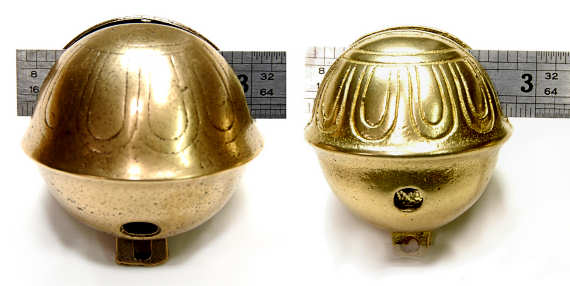

Left: Two #15 bells, one antique (left) and one new (right). A crack on the top of the antique bell has been repaired, so the numeral "1" in the "15" is not clear.
Right: The same two bells, turned around so the measurements can be more clearly seen. The antique #15 bell measures about 3 1/4" across. The new #15 bell measures 2 3/4".
Antique "raspberry" bells and "acorn" bells are unusual and highly collectible. This scarcity is a great incentive to turn modern versions of these bells into "instant antiques" and sell them for steep antique prices. Both styles of bells are still made, although with telling differences from the antiques.
When turned into "instant antiques", new raspberry and acorn bells are usually darkened with a tell-tale rusty patina, and put on straps made of recycled leather.
Another telling clue about the modern raspberry and acorn bells is they have a shank base and are fastened onto their strap with figure-8 bell pins. Antique acorn bells and raspberry bells are all rivet style bells without exception.
Antique raspberry bells (also known as "fish scale" bells) are seldom seen on the North American collectibles market. It is wise to assume any raspberry bell you find is a modern "instant antique" until the facts clearly prove otherwise.
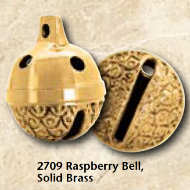
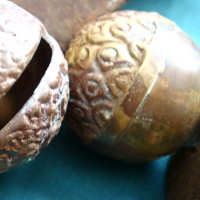
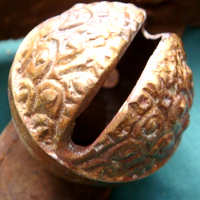
Left: New raspberry bell on a recycled leather strap. The bell has that tell-tale rusty color.
Middle: Other bells on the same strap. The lower half of the right-hand bell is discolored, but very smooth with absolutely no scratches, dings, or other signs of use.
Right: New raspberry bells for sale in a current wholesale catalog. Look familiar?
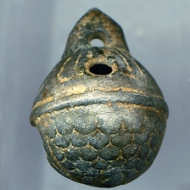
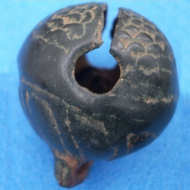

Antique British fish-scale bells (aka raspberry bells). Source: UK Detector Finds Database, http://www.ukdfd.co.uk/

Antique American raspberry bells bear a strong resemblance to their UK cousins. The "scales" on these antique bells are smaller and more detailed than the modern versions. The rusty "button" protruding from the base of the two left-hand bells is the steel rivet that once attached these bells to their strap. The fourth bell is shown still attached to the strap.
Antique acorn bells are not as rare as raspberry/fishscale bells. There were several North American manufacturers of this style, so several antique acorn designs appear on the collectibles market.
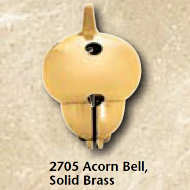

Left: This new acorn bell from a current wholesale catalog is often transformed into an "instant antique" by giving it a darkened patina and putting it on a recycled leather strap. Note the shank base on the bell and the large, bulbous "cap".
Right: The same acorn bells installed on a new strap. Notice the bell pins in the background. Bell pins are only used with shank-style bells, and this is a give-away that these bells are new, despite their aged appearance.


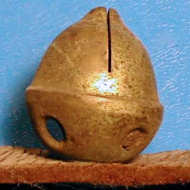
Left: Antique acorn bell with original nickel plating.
Middle: A similar antique acorn bell with a thick layer of dirt and patches of its original nickel (silvery) plating.
Right: Another variety of antique acorn bell with more realistic proportions. Note the separate copper rivet still attached to the base of this bell.
Copyright © 2002-2025 - All rights reserved by Classic Bells Ltd.
Template by OS-templates.com